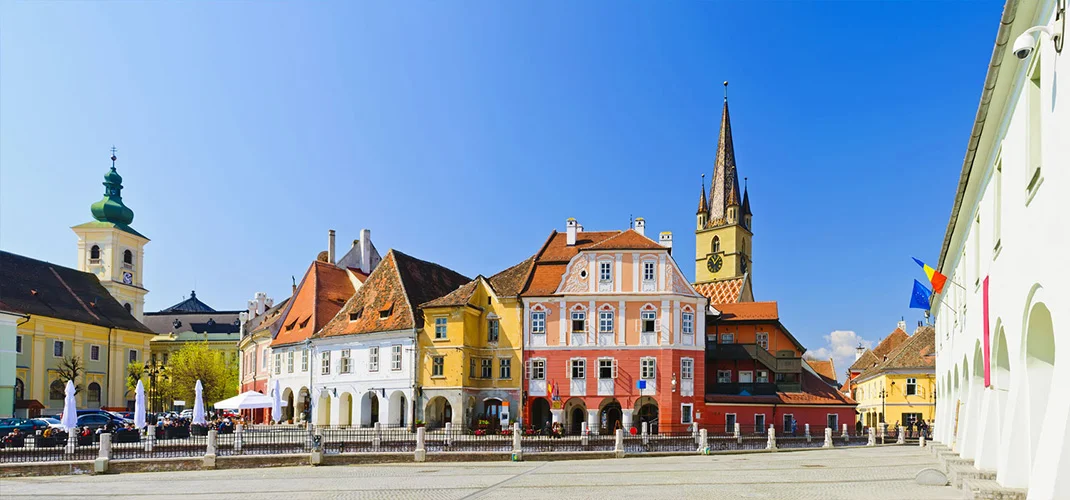Sibiu

Sibiu in situated in Southern Transylvania on a hill with intricate rings of fortifications. This city has made a clear division between the Lower Town for artisans and merchants and the Upper Town for its more affluent citizens and religious elite. Connecting the two is a labyrinth of intertwining alleys, stairways and passages. Descending under vaults and cutting through brick ravines, these paths turn the simple act of getting around into a journey of discovery.
The ASTRA Museum of Traditional Folk Civilisation is situated in the Dumbrava Forest just four kilometres from Sibiu. This terrific outdoor Museum in the Swedish ‘Skansen’ tradition with 96 hectares and a ten kilometre trail taking you past reconstructed dwellings, windmills, animal paddocks, workshops, churches, water mills and farms from all parts of Romania. There are more than 300 buildings, showing off the diversity of styles and ingenuity and resourcefulness of rural folk in Romania. The Museum also has a lake where you can hire a rowboat in the summer and there is an endless sequence of folk celebrations with bright traditional costumes and dance.
Piața Mare (Grand Square) is a large rectangular square in the centre of Sibiu. The Grand Square measures 142 metres long by 93 metres wide, making it one of the largest in Transylvania holding markets and fairs. In the northwest corner of the square is the Brukenthal Palace, one of Romania’s best examples of Baroque architecture.
The Brukenthal National Museum is the palatial home of the Habsburg Governor of Transylvania, Samuel von Brukenthal and it also serves as the headquarters for a Museum, which are situated around Sibiu. This institution was first founded using Brukenthal’s personal collections over 200 years ago. The residence houses the Brukenthal Art Galleries, complete with German, Flemish, Dutch, Italian, French and Spanish paintings from the Renaissance, Baroque and Rococo periods.
The Muzeul de Istorie (Museum of History) is part of the Brukenthal Museum, this attraction is set in the Casa Altemberger, named after Thomas Altemberger, Sibiu’s Mayor in the late 15th Century. The house is an outstanding pieces of secular Gothic architecture. The galleries house glassware crafted nearby in Porumbacu de Sus, a Roman lapidarium from the 1st to 3rd Century, religious art, coins, weapons and armour.
If you proceed through the portal below the Council Tower you will come to the Piața Mică (Small Square), which in actuality is quite large. In the middle, there is a street that spirals down to the Lower Town and crossing the big brick embankments you will find the beautiful Bridge of Lies.
The Bridge of Lies is Romania’s oldest iron bridge, cast in 1859. It links the two halves of the Small Square and it has no standing supports and instead rests on the two embankments, hence why the name is called the Lying Bridge. This is an elegant piece of design, with Neo-Gothic motifs in its ironwork and four wrought iron gas lights on pedestals at each corner.
Lower Town is situated between the Cibin River and the Upper Town, the Lower Town was where merchants and craftsmen lived, as opposed to the Upper Town, which was where you would find families of wealth and nobility and the clergy. The houses are mainly two storeys and more rustic, found on broad cobblestone streets delivering you to small squares. There is a large semi-circular wooden gate that gives way to an interior courtyard.
Stairs Passage is the best path linking the Upper and Lower Towns, which has a moderate, winding slope as it was designed for Oxcarts in the 13th Century. The most photogenic part is found below the Lutheran Cathedral past high brick retaining walls with flying buttresses arching over the passageway for reinforcement. At the foot of the Stairs Passage is the Butoiul de Aur (Golden Barrel), which, dates back to 1452 and is the oldest restaurant in Romania.
Other places of interest include Sibiu’s Lutheran Cathedral, one of the greatest and largest Gothic Churches in Transylvania completed in 1520.
The Baroque Turnul Sfatului (Council Tower), standing between Sibiu’s Grand and Lesser Squares. From 10:00am-20:00pm you can climb the 141 stairs to see the clock mechanism on the 5th floor and enjoy the beautiful views over Sibiu’s rooftops.
For a quick trip back to the steam age there is the Museum of Steam Locomotives. You can find this Museum at a roundhouse and turntable close to the main train station east of the Old Town. There are 33 locomotives to check out, along with three snowploughs and two steam cranes.
